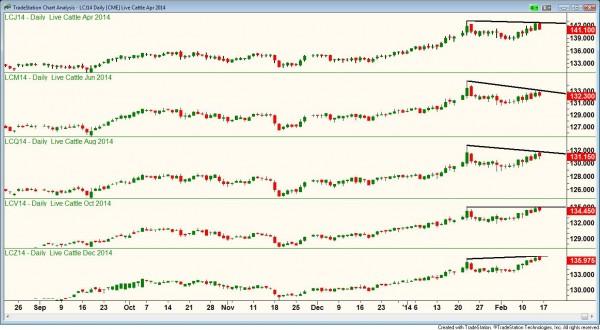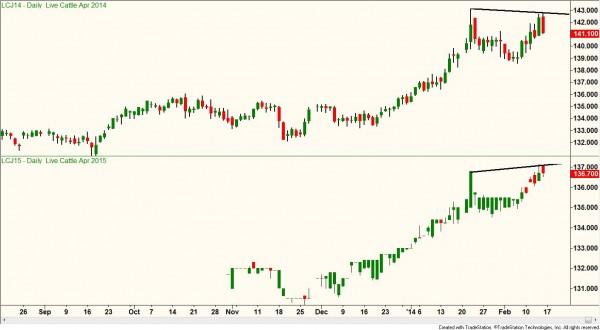Recently I wrote an article on Setting up a Commodity Trade. One of the tools I mentioned was Relative Strength in conjunction with our usual trend and core technical analysis of Supply/Demand. Commodity Futures allow us to take a peek at what the smart money in the market is doing if we know how to read the charts. In this article I would like to discuss how looking at multiple months of the same Commodity can often reveal what the smart money is doing in the market.
In class I point out that the smart money traders are the Commercials. These traders are specialists in the particular market they participate in. A Commercial uses the actual physical Commodity daily in their course of running their business. This means they must know everything there possibly is to know about the fundamental supply/demand factors, seasonal patterns, current situations that may disrupt their distribution/accumulation of the Commodity they produce or process and a host of other things that only a true professional with large resources could possibly gain from market information.
Remember that when it comes to trading Commodity Futures the speculators in the market are only there to move price to the upper price levels for the Producers of a Commodity to lock in hedges. And then to push prices down to the Processors of a Commodity to lock in lower prices for future delivery. Our job as speculators is to try and gain an edge in our trading style that allows us to participate in the same direction as the smart money, Commercial traders do.
Using Relative Strength of various months of a particular Commodity contract is one way to get this edge. There is a technical indicator called Relative Strength Index (RSI), but this article has nothing to do with an indicator. We will be looking at pure price action in real time as it unfolds.
All Commodity Futures contracts have multiple contract months trading simultaneously at any given time of the day. I will be looking at the Live Cattle contract traded on the CME Group Exchange in this article. The Live Cattle contract months traded are February, April, June, August, October and December. Currently April is the front month contract (most actively traded contract of them all) and this is where the majority of speculators will be trading. The other months of Live Cattle are available to the Commercial traders to use for Hedging price risk for futures production and processing of Live Cattle. Speculators are allowed to trade these back months, but rarely do because they do not have much liquidity.
I will be discussing a Seasonal pattern that I found from Moore Research Company (MRCI) on Live Cattle. As a reminder: This is NOT a trade recommendation, it is to be used for educational purposes only.
MRCI has researched the Live Cattle market and found that the April Live Cattle contract has closed lower on March 19 than on February 7 80% of the time in the last 15 years. The average profit has been approximately $618. Another reminder, traders are encouraged NOT to take these Seasonal research patterns blindly. While they may work with high percentage results the drawdowns (losses before closing the position at the optimal exit date) can sometimes be very large. Our job as traders is to apply our own analysis to this research and filter out the markets that meet our criteria to place a trade.
This would mean we need to find supply/demand technical levels for price to retrace back to for entry, trend analysis and or other trade enhancers that we may use to qualify a high probability – low risk trade setup.
Figure 1 will show the next several contracts of Live Cattle being traded as of this writing.

Live Cattle Futures contracts have been making new contract highs recently. Meaning that since the first trading day of the contract a couple of years ago, prices have never traded this high for each of these contracts. Contract highs are a very bullish signal for markets. However, after a market makes several new contract highs there comes a point where there is no more value in a market to new participants and they will quit buying as will trend followers already in the market. At this point demand will become weak and supply from profit taking and Commercial ranchers will take over and cause price to fall.
What we see in the charts above is that around the third week of January, 2014 Live Cattle Futures made their last contract high for the move. Now as the Live Cattle contracts come back to test these highs we see something out of character for higher prices in this market. Can you spot it?
We can see the front month contract is priced higher than the next two contracts in the cycle. This is referred to as an inverted market and again a strong bullish signal. The question is how long has this market been inverted? Looking back I found the market has been inverted for a minimum of 2 years. This bull market may be getting a little long in the tooth.
The interesting thing about the current price structure according to Relative Strength is that the front months of Live Cattle are struggling to get back to the previous contract highs. The back months of October and December are either at the previous contract high or making new contract highs as illustrated by the trend lines I have drawn across the highs of these moves.
When the back months are performing stronger than the front months that usually means Commercial traders are going to be holding back on bringing their Live Cattle to market. If this was a storable Commodity market it would show the product is being stored and delivered at a future date sometime.
If the front months were making new contract highs that would be telling us there is so much fundamental demand for Live Cattle that the Commercial traders are bringing in their Live Cattle immediately to take advantage of the current higher prices.
Looking at these charts I do not see that pattern forming here. With a Seasonal sell in Live Cattle currently in affect and another one coming in early March it is hard to believe we have a lot of upside left in this market. Can we go higher? Of course!!!! A trader would still need to look at their risk/reward on making this type of trade and determine if it fits their trading plan.
If a trader were to look at an un-adjusted continuous daily chart of Live Cattle (@LC=117XN+GJMQVZ) they could find we have some supply over head up to approximately the 145 handle.
Figure 2 is a chart of Live Cattle, but in this example I created a Relative Strength of April 2014 and April 2015. We again see a more pronounced back month price action stronger than the front month.
My experience has shown me this does not work as well with the Financial Futures contracts due to their lack of liquidity in back months. This creates very short durations of contracts with high volume.
Relative Strength can show how the smart money is posturing themselves in the back months of a Commodity compared to the front months.
“I’ve got a theory that if you give 100% all of the time somehow things will work out in the end.” Larry Bird
Don Dawson
This content is intended to provide educational information only. This information should not be construed as individual or customized legal, tax, financial or investment services. As each individual's situation is unique, a qualified professional should be consulted before making legal, tax, financial and investment decisions. The educational information provided in this article does not comprise any course or a part of any course that may be used as an educational credit for any certification purpose and will not prepare any User to be accredited for any licenses in any industry and will not prepare any User to get a job. Reproduced by permission from OTAcademy.com click here for Terms of Use: https://www.otacademy.com/about/terms
Editors’ Picks
EUR/USD comes under pressure near 1.0630

Further gains in the Greenback encourage sellers to maintain their control over the risk complex, forcing EUR/USD to retreat further and revisit the 1.0630 region as the US session draws to a close.
GBP/USD stays firm amid BoE, Fed commentary and US data

GBP/USD edges lower in the second half of the day and trades at around 1.2450. Better-than-expected Jobless Claims and Philadelphia Fed Manufacturing Index data from the US provides a support to the USD and forces the pair to stay on the back foot.
Gold is closely monitoring geopolitics

Gold trades in positive territory above $2,380 on Thursday. Although the benchmark 10-year US Treasury bond yield holds steady following upbeat US data, XAU/USD continues to stretch higher on growing fears over a deepening conflict in the Middle East.
Ripple faces significant correction as former SEC litigator says lawsuit could make it to Supreme Court

Ripple (XRP) price hovers below the key $0.50 level on Thursday after failing at another attempt to break and close above the resistance for the fourth day in a row.
Have we seen the extent of the Fed rate repricing?

Markets have been mostly consolidating recent moves into Thursday. We’ve seen some profit taking on Dollar longs and renewed demand for US equities into the dip. Whether or not this holds up is a completely different story.
RECOMMENDED LESSONS
Making money in forex is easy if you know how the bankers trade!
Discover how to make money in forex is easy if you know how the bankers trade!
5 Forex News Events You Need To Know
In the fast moving world of currency markets, it is extremely important for new traders to know the list of important forex news...
Top 10 Chart Patterns Every Trader Should Know
Chart patterns are one of the most effective trading tools for a trader. They are pure price-action, and form on the basis of underlying buying and...
7 Ways to Avoid Forex Scams
The forex industry is recently seeing more and more scams. Here are 7 ways to avoid losing your money in such scams: Forex scams are becoming frequent. Michael Greenberg reports on luxurious expenses, including a submarine bought from the money taken from forex traders. Here’s another report of a forex fraud. So, how can we avoid falling in such forex scams?
What Are the 10 Fatal Mistakes Traders Make
Trading is exciting. Trading is hard. Trading is extremely hard. Some say that it takes more than 10,000 hours to master. Others believe that trading is the way to quick riches. They might be both wrong. What is important to know that no matter how experienced you are, mistakes will be part of the trading process.

